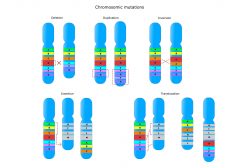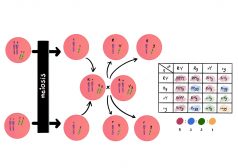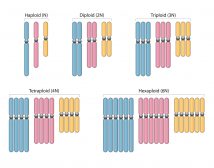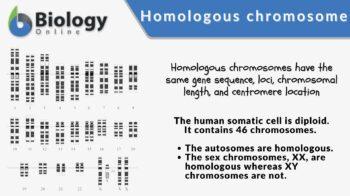
Homologous chromosome
n., plural: homologous chromosomes
[həˈmɒləɡəs ˈkɹoʊməˌzoʊm]
Definition: one of a pair of chromosomes with the same gene sequence, loci, chromosomal length, and centromere location
Table of Contents
A homologous chromosome pertains to one of a pair of chromosomes with the same gene sequence, loci, chromosomal length, and centromere location. A homologous pair consists of one paternal and one maternal chromosome. In humans, there are a total of 46 chromosomes in the nucleus of a somatic cell. Half of them (22 autosomes + X or Y chromosome) are inherited from the father and the other half (22 autosomes + X chromosome), from the mother.
Each maternal chromosome has a corresponding paternal chromosome; they pair up during meiosis. Typically, a female will have 23 homologous chromosomes whereas a male will have 22. That is because the sex chromosomes, X and Y, in males are not homologous. The pairing up of homologous chromosomes during meiosis is important to promote genetic variation.
Because of the genetic recombination that occurs between homologous pairs at meiosis, the resulting haploid gametes contain chromosomes that are genetically different from each other. This amplifies the gene pool, thereby, increasing the chances of acquiring genes essential to biological fitness and survival.
Want to know about homologous chromosome? Join us and participate in our Forum discussion: Difference Between Homologous Chromosomes and Sister Chromatids
Homologous Chromosome Definition
In biology, homologous chromosomes are paired chromosomes. They essentially have the same gene sequence, loci (gene position), centromere location, and chromosomal length. Although they may have the same genetic sequence and loci, they may differ in alleles. The homologous pair is comprised of a paternal chromosome and a maternal chromosome. These chromosomes pair up during meiosis but not during mitosis.
Etymology
The term homologous came from Greek homologos, meaning “agreeing” or “of one mind”. It is a combination of homos, meaning “same” and logos, meaning “relation”. The term chromosome was coined in 1889 by German anatomist, Wilhelm von Waldeyer-Hartz. It was derived from the Greek khrōma, meaning “color” since it readily stained with basic dyes. Synonym: homologue.
Homologous Chromosomes vs. Heterologous Chromosomes
When chromosomes are homologous, it means that they are the same, at least in terms of the gene sequences and loci. Heterologous, in essence, means “different”. This means that heterologous (non-homologous) chromosomes would, therefore, pertain to any two chromosomes that are different, such as in terms of gene sequence and loci. During meiosis, homologous chromosomes may naturally exchange genetic material. Heterologous chromosomes do not. However, there are instances wherein heterologous chromosomes do exchange chromosomal parts. When this occurs, the process is called chromosomal translocation. It is a form of mutation that could lead to severe chromosomal aberrations. For the comparison between homologous chromosomes and heterologous chromosomes, see Table 1.
Table 1: Differences between homologous chromosomes and heterologous chromosomes | |
|---|---|
| Homologous chromosomes have alleles on the same genes located in the same loci. | Heterologous chromosomes have alleles on different genes. |
| Pairs up during meiosis | Does not pair up during meiosis |
| Gene exchanges may occur at synapses. | Gene exchanges may occur at translocation. |
Basic parts:
| Basic parts:
|
Examples:
| Examples:
|
Homologous chromosome vs. sister chromatids
At meiosis, each of the homologous chromosomes is comprised of two identical chromatids joined together by a common kinetochore (centromere). The identical chromatids are specifically called sister chromatids to distinguish them from the so-called non-sister chromatids. Prior to cell divisions, the chromosomes in the nucleus appear as threadlike strands called chromatins. When a cell is fated to undergo mitosis or meiosis, chromatins condense into thicker structures. By this time, the chromatin is referred to as a chromosome.
The DNA in the chromosome replicates by DNA replication during the S phase of the interphase. After replicating, there would have been two DNA copies, each present in a strand called a chromatid. The two chromatids joined by a common centromere are referred to as sister chromatids. The chromatids of the other member of a homologous pair are referred to as non-sister chromatids.
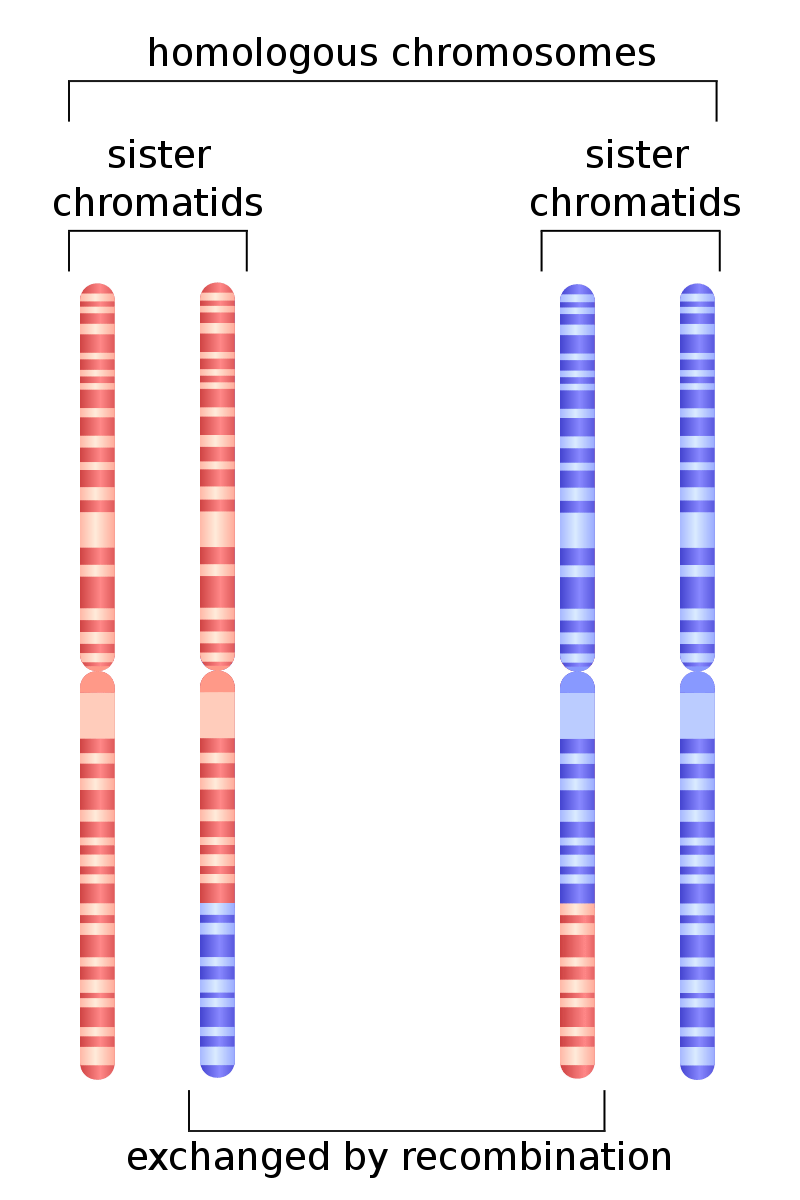
Explore more! Join our Forum: Difference Between Homologous Chromosomes and Sister Chromatids. Let’s talk!
Characteristics
The chromosomes of a eukaryotic cell are located in the nucleus. The chromosomes in the nucleus are of two sets. One set would come from the male gamete (sperm cell) and the other set, from the female gamete (egg cell). Prior to fertilization, both gametes are haploid. When the sperm cell successfully fertilizes the egg cell the resulting zygote is a diploid, which means the union of the two haploid cells results in a single cell with two sets of chromosomes: one set that is maternally derived and another set that is paternally derived. Each maternal chromosome has a corresponding paternal chromosome of the same gene sequence, gene loci, chromosomal length, and centromere location. The pair comes close to each other during meiosis so that they could exchange genes between sister and non-sister chromatids.
Although both members of the homologous pair have similar genes and loci, they may differ in the alleles. For example, both of them carry genes coding for the eye color trait. One has alleles for the brown-eye trait whereas the other, for the blue-eye trait. In this case, the alleles are different and the homologous chromosomes are described as heterozygous. On the contrary, when the alleles are the same (e.g. both alleles for the same gene code for the blue-eye trait) then, they are said to be homozygous. The significance of alleles was demonstrated by Gregor Mendel through his pioneering works in genetics using garden peas. He was able to show that one of the alleles may be dominant over the other. In this case, only one allele will be expressed. A trait demonstrating this pattern is referred to as Mendelian inheritance. Nevertheless, in humans, genetic expressions are not straightforward. Many of the human traits do not conform to the Mendelian pattern of inheritance. In this regard, they are referred to as non-Mendelian.
Homologous chromosomes | |
|---|---|
| Maternal chromosome | Paternal chromosome |
| Inherited from the mother | Inherited from the father |
| Same genetic sequence, loci, chromosomal length, and centromere location | |
| Alleles may be the same or different | |
Meiosis and The Pairing Process
Meiosis is a form of cell division wherein diploid organisms halve their number of chromosomes and homologous chromosomes pair up. In contrast, mitosis (another form of cell division) results in two daughter cells, each containing the same chromosomal number as the parent cell. In meiosis, a diploid (2n) cell will give rise to four haploid (n) cells.
The cells that undergo meiosis are the gametes producing haploid sperm cells and egg cells. Haploidy is essential so that at fertilization the chromosomal number remains the same throughout generations.
In order to achieve haploidy, the cell undergoes two consecutive nuclear divisions. They are referred to as meiosis I and meiosis II.
- To prepare the cell for meiosis, one of the major preparatory steps is DNA replication. The chromosomes duplicate their DNA, particularly in the S phase of interphase. At this point, each of the chromosomes will consist of two strands (sister chromatids) joined at the centromere.
- The pairing (synapse) of homologous chromosomes will occur at prophase I. DNA exchanges occur between homologous chromosomes via homologous recombination and crossover at chiasmata between non-sister chromatids.
- The homologous pairs line up at the metaphase plate.
- Next, the homologous chromosomes separate during anaphase I and move to the opposite poles of the cell.
- The cell divides for the first time during telophase I resulting in two genetically non-identical daughter cells but with sister chromatids still intact.
- Each cell will undergo meiosis II so that the resulting daughter cells will each have a chromosomal number reduced by half.
Human karyotype
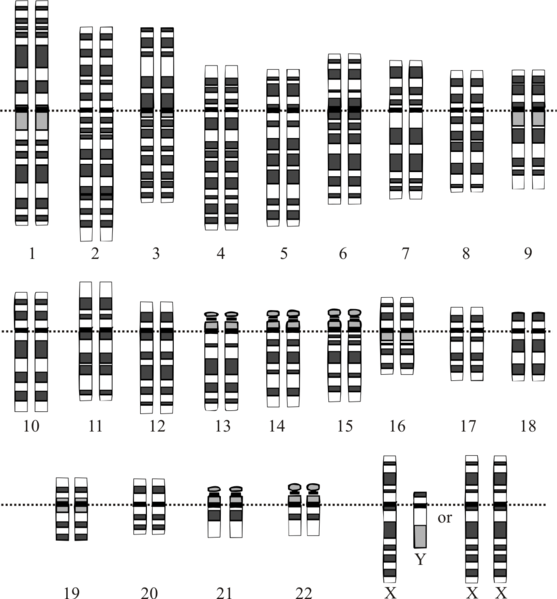
In humans, the nucleus typically contains 46 chromosomes. Thus, there are 22 pairs of autosomes with approximately the same length, staining pattern, and genes with the same loci.
As for the sex chromosomes, the two X chromosomes are considered homologous whereas the X and Y chromosomes are not. Thus, females have 23 homologous chromosomes (i.e. 22 autosomes + 1 X-X chromosomes) whereas males have only 22.
Importance
The chromosomes are essential to all living things because they carry the genetic instructions for all of the cell’s activities. They also bear the genetic information that determines the traits of an organism. Homologous chromosomes, therefore, are vital in the same way.
They carry genetic information that has been passed down from one generation to the next. And since alleles may possibly be different in the same gene, the result is varying phenotypes. Thus, the distinctiveness of an individual of the same species is established.
Apart from this, the organism is capable of reproducing offspring that is genetically different from itself as well as from the rest of its descendants. The homologous chromosomes in the nucleus of the organism’s gamete pair up during meiosis. This event is crucial to promote genetic variation.
The homologous pair exchanges genes via genetic recombination so that genetic diversity may be promoted. This is regarded as one of the advantages of having been able to reproduce sexually. Those that reproduce asexually could create a clone of themselves. Thus, this could reduce diversity in the gene pool.
- A small gene pool means low genetic diversity. It could be unfavorable because it means there is less opportunity to acquire genes essential for adapting to an environment prone to inexorable physicochemical changes.
- In contrast, greater genetic variability means a higher propensity to acquire better genes. High genetic diversity also means a large gene pool. This, in turn, implicates increased chances of acquiring genes that could enhance biological fitness and survival.
Got questions on homologous chromosomes? Join our Forum: Difference Between Homologous Chromosomes and Sister Chromatids. Our community may be able to help!
NOTE IT!
The Silencing of the X Chromosome in a Homologous Pair
Did you know that one of the two X chromosomes in a homologous pair is silenced in developing female embryos (as early as the 8-cell blastocyst stage)?
Only one of the X chromosomes of the homologous pair will be expressed. The other will forever be silenced.
One of the two X chromosomes would have its XIST (X–inactive-specific transcript) gene free to produce XIST molecules (long noncoding RNAs), which it will use to coat itself, rendering itself inactive. The process entails a self-inactivation tactic as if sacrificing itself for the other X chromosome that shall be identified as the “active” X chromosome (Xa). Scientists claim that this is a random event. The X chromosome from either the father or the mother will have to deal with a 50% chance of getting activated or inactivated.
Once inactivated irreversibly (~at 16-cell stage), all the subsequent somatic cells produced through mitosis will carry the same inactivated X chromosome (Xi).
As the genes in the Xa chromosome are transcribed and expressed, the genes (except for the so-called “escape genes”) in the Xi chromosome will not be expressed. The Xi chromosome coated with XIST RNAs turns into a dense Barr body in the nucleus after undergoing histone modifications and epigenetic changes that make it transcriptionally inactive.
“Why?”, you might ask.
The is to maintain gene dosage balance for X-linked genes between males (XY) and females (XX). Also, if both X chromosomes are active it could end up producing gene products more than what the cell needs. Because the cell cannot utilize them all quickly, they accumulate and become toxins, and thus, amplify cellular stress. This, in turn, can result in cell damage and inflammation.
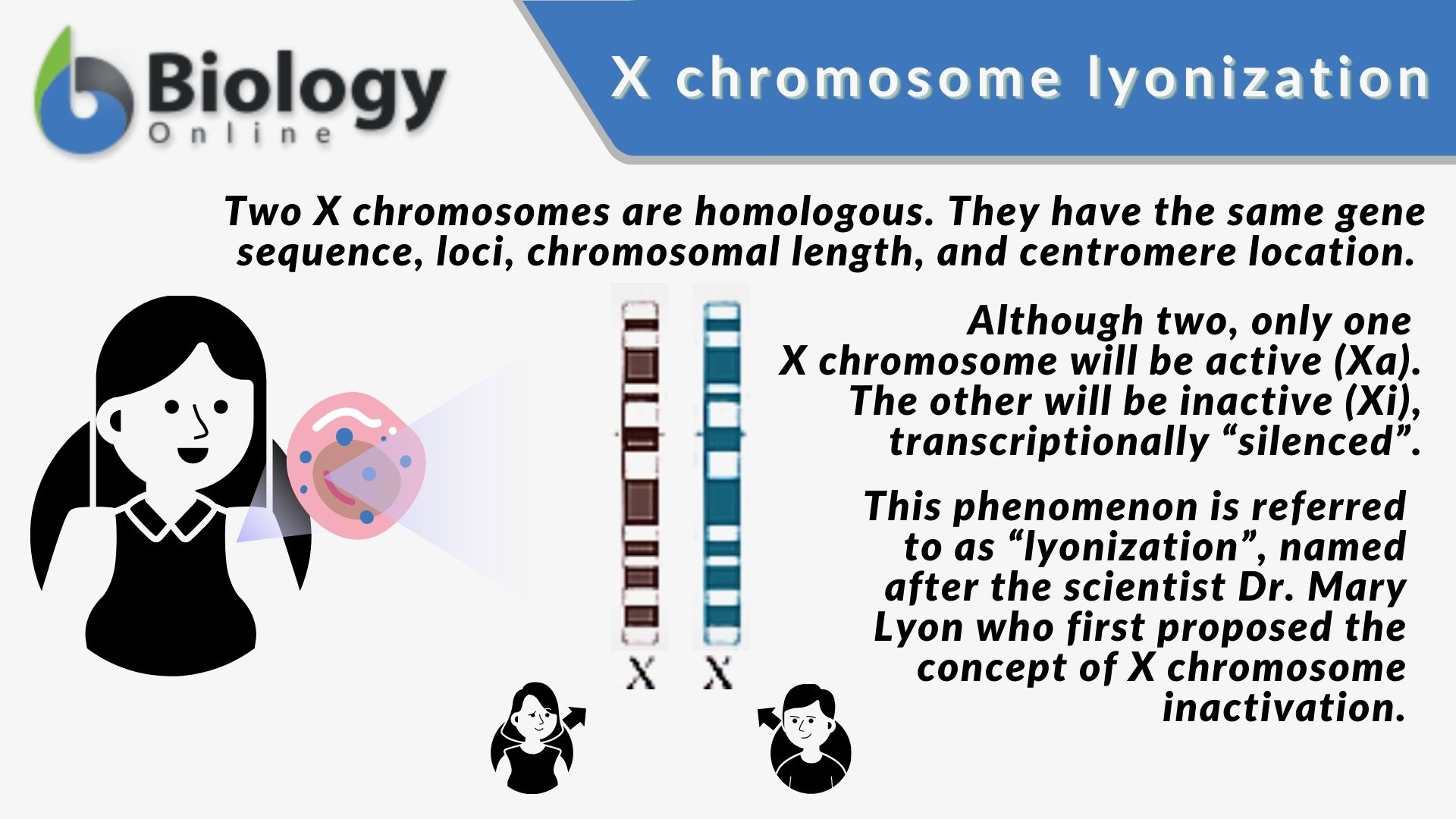
Try to answer the quiz below to check what you have learned so far about homologous chromosomes.
Further Reading
References
- homologous chromosomes definition. (2019). Retrieved from Northwestern.edu website: http://groups.molbiosci.northwestern.edu/holmgren/Glossary/Definitions/Def-H/homologous_chromosomes.html
- Alberts, B., Johnson, A., Lewis, J., Raff, M., Roberts, K., & Walter, P. (2017). Meiosis. Retrieved from Nih.gov website: https://www.ncbi.nlm.nih.gov/books/NBK26840/
- Meiosis Tutorial. (2019). Retrieved from Arizona.edu website: http://www.biology.arizona.edu/cell_bio/tutorials/meiosis/main.html
- Human Genetics. (2019). Retrieved from Estrellamountain.edu website: https://www2.estrellamountain.edu/faculty/farabee/biobk/BioBookhumgen.html
- Cell division: mitosis and meiosis. (2018, May 8). Retrieved from Biology 1510 Biological Principles website: http://bio1510.biology.gatech.edu/module-4-genes-and-genomes/4-1-cell-division-mitosis-and-meiosis/
- Alleles. (2018). Retrieved from Bu.edu website: http://sphweb.bumc.bu.edu/otlt/MPH-Modules/PH/DNA-Genetics/DNA-Genetics5.html
© Biology Online. Content provided and moderated by Biology Online Editors

